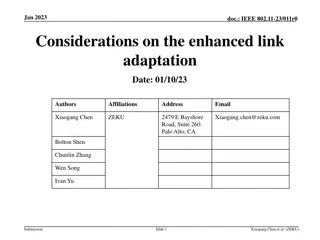Understanding Fossorial Adaptation in Animals
Animals adapt to subterranean environments through anatomical and physiological modifications in a process known as fossorial adaptation. This adaptation involves creating subterranean zones through digging, leading to changes influenced by both the environment and the animals themselves. Fossorial animals can be classified into three categories based on their digging behavior and modifications. Physical adaptations include spindle-shaped bodies, reduced eyesight, and specialized forelimbs with long claws for burrowing.
- Fossorial Adaptation
- Animals
- Subterranean Environment
- Anatomical Modifications
- Physiological Modifications
Download Presentation

Please find below an Image/Link to download the presentation.
The content on the website is provided AS IS for your information and personal use only. It may not be sold, licensed, or shared on other websites without obtaining consent from the author. Download presentation by click this link. If you encounter any issues during the download, it is possible that the publisher has removed the file from their server.
E N D
Presentation Transcript
Meaning of Fossorial Adaptation: The adjustment of animals through their anatomical and physiological modification to the subterranean environment is known as fossorial adaptation. Generally, environment acts upon animals to modify the structural designs.
But in fossorial adaptation the animals change the environments by making a subterranean zone through digging of its own. Hence by the influences of environments as well as animals itself, adaptive changes are acquired.
Classification of Fossorial Adaptation: Fossorial animals may be classified into three categories: i. Animal digging the soil for food: They are considered as a first step towards fossorial form. They dig the soil by snout or tusk, e.g., elephant, swine, etc. Apart from this, there is but little fossorial adaptation that can be noted. In elephants, the entire modification of skull is for digging mechanism.
ii. Animals digging for retreats but seek their food above the ground: These are the next forms whose limbs become shorter but they have no extreme modifications, e.g., fox, mongoose, etc.
iii. Animals digging for retreat but find their food under the ground: They have got extreme modification for fossorial life, e.g., Talpa sp., Rattus etc.
Physical adaptations: There are six major external modifications, as described by H.W. Shimer in 1903, that are shared in all mammalian burrowing species: Fusiform, a spindle-shaped body tapering at both ends, adapted for the dense subsurface environment. Lesser developed or missing eyesight, considering subsurface darkness.
Broad and stout forelimbs (manus), including long claws, designed to loosen the burrowing material for the hind feet to disperse in the back. This trait is disputed by Jorge Cubo, who states that the skull is the main tool during excavation, but that the most active parts are the forelimbs for digging and that the hind-limbs are used for stability.
Short and stout limbs, since swiftness or speed of movement is less important than the strength to dig. Short or missing tail, which has little to no locomotor activity or burrowing use to most fossorial mammals Small or missing external ears, to reduce naturally occurring friction during burrowing.
Other important physical features include a subsurface adjusted skeleton: a triangularly shaped skull, a prenasal ossicle, chisel-shaped teeth, effectively fused and short lumbar vertebrae, well-developed sternum, strong forelimb and weaker hind limb bones.
Several different uses are well documented. The Cape mole rat (Georychus capensis) uses drumming behavior to send messages to its kin through conspecific signaling.
Due to the lack of light, one the most important features of fossorial animals are the development of physical, sensory traits that allow them to communicate and navigate in the dark subsurface environment. Considering that sound travels slower in the air and faster through solid earth, the use of seismic (percussive) waves on a small scale is more advantageous in these environments.
Physiological modifications: Many fossorial and sub-fossorial mammals that live in temperate zones with partially frozen grounds tend to hibernate due to the seasonal lack of soft, succulent herbage and other sources of nutrition.
The average fossorial animal has a basal rate between 60% and 90%. Further observations conclude that larger burrowing animals, such as hedgehogs or armadillos, have lower thermal conductance than smaller animals, most likely to reduce heat storage in their burrows.
W.H. Shimer concluded that, in general, species that adopted fossorial lifestyles likely did so because they failed, aboveground, to find food and protection from predators. Additionally, some, such as E. Nevo, propose that fossorial lifestyles could have occurred because aboveground climates were harsh.
Shifts towards an underground lifestyle also entail changes in metabolism and energetics, often in a weight-dependent manner. Sub-fossorial species weighing more than 80 grams (2.8 oz) have comparably lower basal rates than those weighing lower than 60 grams (2.1 oz).























